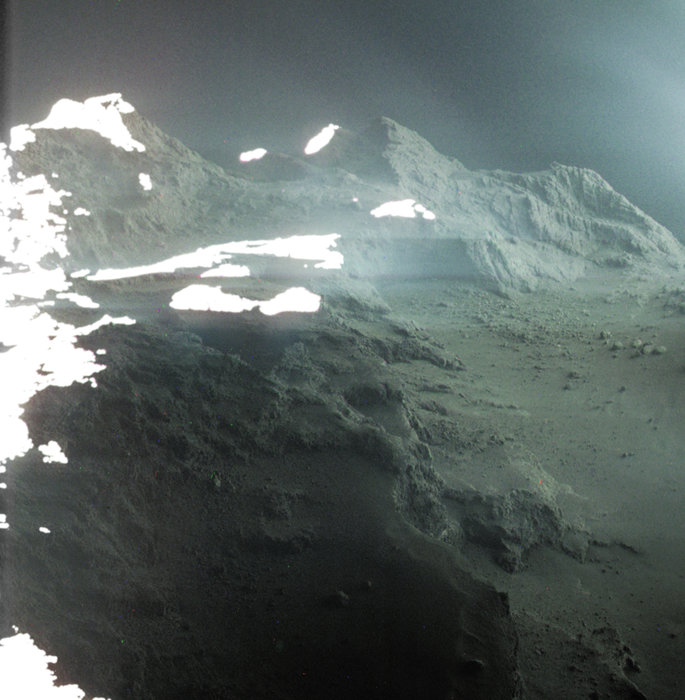Did comets deliver the elements essential for life on Earth? It's looking more and more like they could have. At least one comet might have, anyway: 67P/Churyumov-Gerasimenko.
A new study using data from the ESA's Rosetta mission shows that the comet contains the life-critical element phosphorous.
Researchers from the University of Turku in Finland led this research. The lead author of the study is Esko Gardner, an astrophysicist and software engineer.
The title of the work is "The detection of solid phosphorus and fluorine in the dust from the coma of comet 67P/Churyumov-Gerasimenko," and it's published in Monthly Notices of the Royal Astronomical Society.
The raw elements for life are known as CHNOPS, which stands for Carbon, Hydrogen, Nitrogen, Oxygen, Phosphorous, and Sulfur. Combinations of these six chemical elements make up the large majority of biological molecules on Earth. Together, they account for almost 98 percent of Earth's living matter.
Scientists had previously found the other five in comets, so finding phosphorous might be the final piece of this puzzle.
The team of researchers found the phosphorous and fluorine in the inner coma of comet 67P/Churyumov-Gerasimenko. They were present in solid particles collected only a few kilometres from the comet by Rosetta's COmetary Secondary Ion Mass Analyser (COSIMA) instrument.
The particles were collected on the instrument's target plates, which were then photographed remotely. The individual particles were selected in the images and then measured with a mass spectrometer.
This was all done from Earth before Rosetta ended its mission with a controlled crash into Comet 67P at the end of September 2016.
 The landscape of Comet 67P/Churyumov-Gerasimenko. (ESA/Rosetta)
The landscape of Comet 67P/Churyumov-Gerasimenko. (ESA/Rosetta)
Phosphorous has been found in comets before. In a 1987 paper, researchers announced the detection of phosphorous in dust from Halley's comet. But it was likely atomic phosphorous contained in an uncertain mineral and chemically unavailable.
Then in 2006, NASA's Stardust spacecraft returned samples from comet 81P/Wild. Researchers found a single particle containing phosphorous, which was associated with calcium.
Scientists concluded that the phosphorous was "most likely contained within an apatite particle." It was also likely unavailable.
This new finding is different: This time researchers found phosphorous ions in solid particles in either minerals or metallic phosphorous.
"We have shown that apatite minerals are not the source of phosphorus, which implies that the discovered phosphorus occurs in some more reduced and possibly more soluble form," said the project leader Harry Lehto from the Department of Physics and Astronomy at the University of Turku.
The press release accompanying the research states that "[t]his is the first time that life-necessary CHNOPS elements are found in solid cometary matter."
The new finding is important to the understanding of how life came to be on Earth. Phosphorous is critical to life on Earth, but if it's locked into an apatite mineral, it's largely out of reach. If it's in its gaseous form, it's also unsuitable.
But the newly-discovered phosphorous is more available. As the authors write in their paper, "In the process of forming life, water-soluble reactive phosphorus compounds were required to convert nucleotide precursors by phosphorylation to active nucleotides."
Phosphorous is one of the missing pieces in the puzzle of life on Earth. There was a lack of molecules containing soluble phosphorous on early Earth. Experiments have shown that soluble phosphorous could serve a critical role in the origin of biological molecules.
"It has been experimentally shown that soluble P, HCN and H2S can serve as suitable feed stock for the prebiotic synthesis of nucleotides, amino acids and phosphoglycerine backbones," the authors write.
 A short-lived outburst from Comet 67P/Churyumov-Gerasimenko. (ESA/Rosetta)
A short-lived outburst from Comet 67P/Churyumov-Gerasimenko. (ESA/Rosetta)
But the most efficient way of producing those biological molecules involves highly reduced forms of phosphorous. Those forms of phosphorous occur mostly in meteoritic materials, or possibly in elemental phosphorous.
Up until now, meteorites, or possibly geochemical processes, were known to be responsible for the prebiotic phosphoric materials necessary for life.
But this study shows that, along with CHNO and S, P is now known to be present in comets, and those comets could have delivered P to early Earth.
But there's still a problem with the comet delivery idea. If the impact is too energetic, materials can be destroyed or altered. The team behind this new research thinks they may have an answer to that.
"It is conceivable that early cometary impacts onto the planet surface have been less energetic, as compared to the impacts of the heavy stony meteorites, thus preserving the prebiotic molecules in a more intact condition."
The researchers are still appropriately cautious about their results. The results show that the elements for life can come from comets, but those compounds must be soluble and available. They can't be locked into minerals.
"The solubility of the detected cometary phosphorus from 67P/C-G is not clear, but we can conclude that it cannot be Apatite, which is a common mineral source of phosphorus in meteorites. Additionally, other phosphate minerals are unlikely, because we could not find a clear cometary contribution of PO2? and PO3?."
So what's next?
The authors think a comet sample-return mission is necessary to advance the comet CHNOPS delivery idea.
"The presence of all the CHNOPS-elements gives a strong premise for a future cometary sample-return mission to a comet. This could confirm the presence of all compounds and their possible mineral sources and the possible solubility of the matter. This would also allow for a comprehensive analysis of the relative amounts of these CHNOPS-elements."
NASA's Stardust mission captured and returned comet dust materials from the coma of Comet 81P/Wild 2. And scientists learned a lot from those samples. But those samples, though important, suffered from some limitations.
In the report "The Comet Coma Rendezvous Sample Return (CCRSR) Mission Concept – The Next Step Beyond Stardust" the authors pointed out that "[t]hese samples have important limitations, however, because they were collected in modest numbers at harsh hypervelocities and represent a one-time random sampling of the coma (a 'grab' sample)."
How could that be improved? In the same report, the authors described what an improved comet sample-return mission would look like.
"This mission utilizes a spacecraft designed to rendezvous with a comet, make extended observations within the cometary coma (but not land on the comet), gently collect multiple coma samples representing different source sites, and return them to Earth for study."
The benefits? "First, the samples will be captured at far lower velocities, eliminating sample destruction and alteration during collection, and resulting in the return of much more pristine material, especially organics and fragile minerals."
This improved mission would also collect samples from the coma and from jets of off-gassing volatiles. It would also collect a lot more material, making the sample more relevant statistically.
For now, that updated mission is just a concept. And there are no shortages of worthy mission concepts out there. It's just a matter of selecting the most worthy ones.
NASA? ESA? Are you listening?
This article was originally published by Universe Today. Read the original article.
